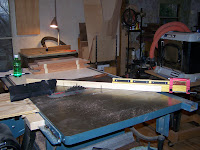Being Monday I spent the morning doing bookkeeping chores, being month end AND year end, I came in at 5:00 this morning to get some extra time to work on these things.
After lunch I got going again on Jim’s Wall Hung Stopper Rack. I still needed to make and sand the side pieces, fit the shelves I made earlier into them and make the apron.
 Once all that was done I took the parts into the assembly room and assembled them. They are there now, hidden under a collection of clamps that will remain in place overnight.
Once all that was done I took the parts into the assembly room and assembled them. They are there now, hidden under a collection of clamps that will remain in place overnight.
Once they come off I’ll sand the rack again to remove and clamp marks, install the hangers and ship it off. Jim want’s to paint his rack to match their room décor so it’s going out unfinished.
Tomorrow is New Years Day and the Smoky Mountain Woodworks workshop will be closed. The web site will be open to serve you.
Thanks for stopping in, see you next year!
Doug
After lunch I got going again on Jim’s Wall Hung Stopper Rack. I still needed to make and sand the side pieces, fit the shelves I made earlier into them and make the apron.
 Once all that was done I took the parts into the assembly room and assembled them. They are there now, hidden under a collection of clamps that will remain in place overnight.
Once all that was done I took the parts into the assembly room and assembled them. They are there now, hidden under a collection of clamps that will remain in place overnight.Once they come off I’ll sand the rack again to remove and clamp marks, install the hangers and ship it off. Jim want’s to paint his rack to match their room décor so it’s going out unfinished.
Tomorrow is New Years Day and the Smoky Mountain Woodworks workshop will be closed. The web site will be open to serve you.
Thanks for stopping in, see you next year!
Doug






.JPG)



































